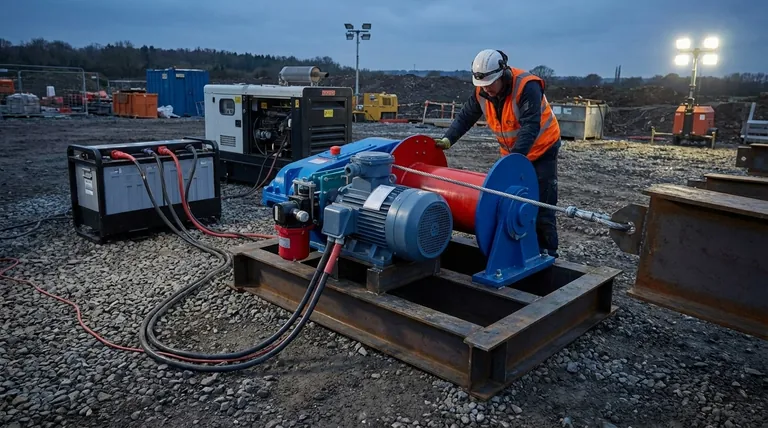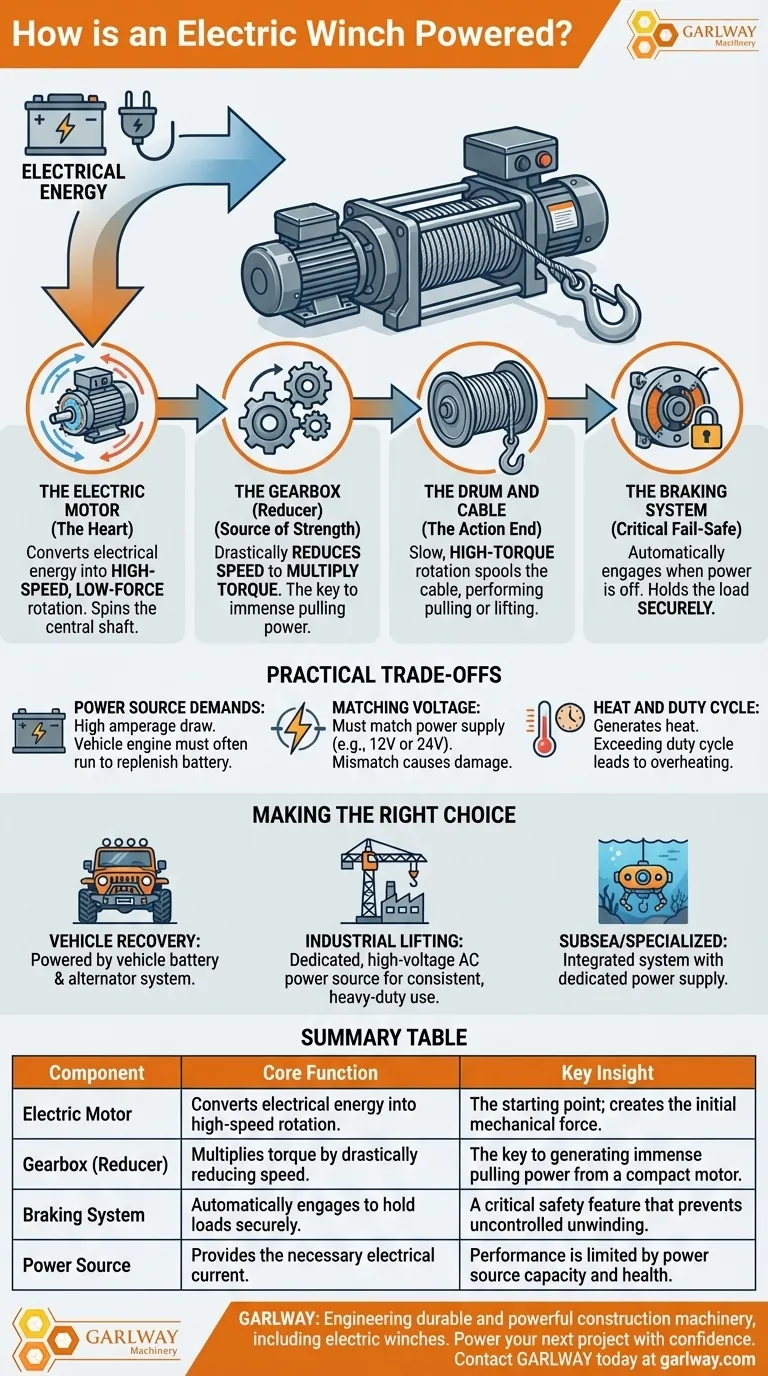At its core, an electric winch is powered by an electric motor. This motor converts electrical energy, typically drawn from a vehicle's battery or another dedicated power source, into the mechanical force required to pull or lift heavy loads. The entire system is designed to transform this electrical input into powerful, controlled motion.
The essential principle is not just the motor itself, but how its high-speed, low-force rotation is converted into low-speed, high-force pulling power. This transformation is achieved through a critical partnership between the motor and the gearbox.

The Powertrain: From Electricity to Mechanical Force
An electric winch is a system of interconnected components, each with a specific job in converting electricity into work. Understanding this powertrain is key to understanding the winch's capabilities.
The Electric Motor: The Heart of the System
The motor is the prime mover. It takes in electrical current and uses it to create a rotating magnetic field, which spins a central shaft.
This initial rotation is fast but relatively weak in terms of raw turning force, or torque.
The Gearbox (Reducer): The Source of Strength
This is arguably the most critical component for generating power. The motor's rapidly spinning shaft connects to a series of gears inside the gearbox.
These gears are arranged to drastically reduce the speed of the rotation. Through the principle of mechanical advantage, as the speed decreases, the torque is multiplied significantly.
This is how a compact electric motor can generate enough force to pull thousands of pounds. It trades speed for immense power.
The Drum and Cable: The Action End
The slow, high-torque output from the gearbox is connected to the winch drum. As the drum rotates, it spools a steel cable or synthetic rope, performing the actual pulling or lifting.
The controlled rotation allows for precise positioning of heavy loads.
The Braking System: The Critical Fail-Safe
Electric winches are equipped with a brake, often electromagnetic. When the motor is not powered, the brake automatically engages.
This prevents the drum from unwinding under load, securely holding the object in place and ensuring operational safety.
Understanding the Practical Trade-offs
While powerful, an electric winch's performance is bound by the realities of its power source and mechanical design.
Power Source Demands
An electric winch under load draws a very high amount of electrical current (amperage). This places a significant strain on the power source.
For vehicle-mounted winches, this often means the vehicle's engine must be running to allow the alternator to replenish the battery during use.
Matching Voltage
The winch motor's voltage rating (e.g., 12V or 24V) must exactly match the power supply. A mismatch will prevent the winch from functioning correctly and can cause severe damage.
Heat and Duty Cycle
Converting electricity into force generates significant heat in the motor. Electric winches have a "duty cycle," which is the maximum time they can run before needing to cool down.
Exceeding this duty cycle can lead to overheating and permanent motor damage.
Making the Right Choice for Your Goal
The ideal power setup depends entirely on the winch's intended application.
- If your primary focus is vehicle recovery: Your winch will be powered by the vehicle's battery and alternator system, making the health of that system paramount for reliable operation.
- If your primary focus is industrial lifting: The winch will likely use a dedicated, high-voltage AC power source from the electrical grid to ensure consistent, heavy-duty performance without time limits.
- If your primary focus is subsea or specialized operations: The winch will be part of an integrated system with a dedicated power supply designed for the specific demands and environment of the task.
Understanding that an electric winch is a complete power conversion system—not just a motor—is the key to operating it safely and effectively.
Summary Table:
| Component | Core Function | Key Insight |
|---|---|---|
| Electric Motor | Converts electrical energy into high-speed rotation. | The starting point; creates the initial mechanical force. |
| Gearbox (Reducer) | Multiplies torque by drastically reducing speed. | The key to generating immense pulling power from a compact motor. |
| Braking System | Automatically engages to hold loads securely. | A critical safety feature that prevents uncontrolled unwinding. |
| Power Source | Provides the necessary electrical current (e.g., 12V/24V battery). | Performance is limited by the power source's capacity and health. |
Need a Reliable Winch for Your Project?
Understanding the power behind an electric winch is the first step. Choosing the right one for your specific needs is what ensures success and safety on the job site.
GARLWAY specializes in engineering durable and powerful construction machinery, including a full range of electric winches, concrete mixers, and batching plants. We provide solutions for construction companies and contractors globally who demand reliability and performance.
Let us help you power your next project with confidence. Our experts can guide you to the perfect winch for your vehicle recovery, industrial lifting, or specialized application.
Contact GARLWAY today for a consultation and discover the difference quality machinery makes!
Visual Guide

Related Products
- Electric and Hydraulic Winch for Heavy Duty Applications
- Electric 120V Boat Winch by Badlands
- 12000 lb Heavy Duty Electric Boat Winch
- Electric Hoist Winch Boat Anchor Windlass for Marine Applications
- Heavy Duty Electric Boat Winch Windlass Anchor
People Also Ask
- How to power an electric winch on a trailer? Choose the Best Method for Your Setup
- Can you use an electric winch manually? A Guide to Dual-Functionality Winches
- How long can you run an electric winch? Master Safe, Efficient Vehicle Recovery
- How does the electric winch work? Unlock the Power of Force Multiplication
- How to maintain an electric winch? Ensure Peak Performance & Reliability for Your Projects



















